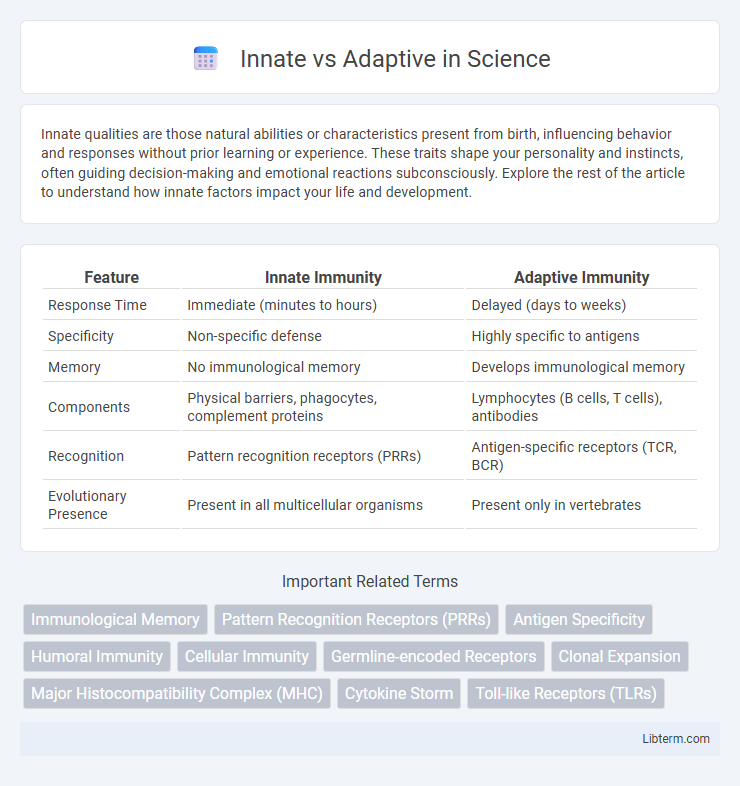Innate qualities are those natural abilities or characteristics present from birth, influencing behavior and responses without prior learning or experience. These traits shape your personality and instincts, often guiding decision-making and emotional reactions subconsciously. Explore the rest of the article to understand how innate factors impact your life and development.
Table of Comparison
| Feature | Innate Immunity | Adaptive Immunity |
|---|---|---|
| Response Time | Immediate (minutes to hours) | Delayed (days to weeks) |
| Specificity | Non-specific defense | Highly specific to antigens |
| Memory | No immunological memory | Develops immunological memory |
| Components | Physical barriers, phagocytes, complement proteins | Lymphocytes (B cells, T cells), antibodies |
| Recognition | Pattern recognition receptors (PRRs) | Antigen-specific receptors (TCR, BCR) |
| Evolutionary Presence | Present in all multicellular organisms | Present only in vertebrates |
Introduction to Innate and Adaptive Immunity
Innate immunity is the body's first line of defense, providing rapid, nonspecific protection against pathogens through barriers like skin, phagocytic cells, and inflammatory responses. Adaptive immunity develops more slowly, targeting specific antigens with highly specialized cells such as B lymphocytes and T lymphocytes, enabling immunological memory for faster response upon re-exposure. These two branches work collaboratively to maintain immune homeostasis and effectively eliminate infections.
Defining Innate Immunity
Innate immunity constitutes the body's first line of defense, offering immediate, non-specific protection against pathogens through physical barriers like skin, chemical barriers such as mucous secretions, and cellular components including macrophages and natural killer cells. Unlike adaptive immunity, innate immune responses do not require prior exposure to a pathogen and rely on pattern recognition receptors (PRRs) to detect common microbial structures called pathogen-associated molecular patterns (PAMPs). This system initiates inflammatory responses and activates the complement cascade, quickly containing infections and signaling for adaptive immunity activation.
Key Features of Innate Immune Response
The innate immune response provides the body's first line of defense through physical barriers, phagocytic cells, and inflammatory processes, offering rapid but non-specific protection against pathogens. Key features include pattern recognition receptors (PRRs) that identify common microbial structures, enabling immediate activation of immune cells. This response lacks immunological memory, distinguishing it from the adaptive immune system's targeted and long-lasting defense mechanisms.
Defining Adaptive Immunity
Adaptive immunity is a highly specialized defense mechanism that develops after exposure to specific pathogens, characterized by its ability to recognize and remember distinct antigens. It involves lymphocytes, primarily B cells and T cells, which undergo clonal expansion and differentiation to target and eliminate invading microorganisms. This immune response provides long-lasting protection through immunological memory, enabling faster and more effective reactions upon subsequent exposures.
Hallmarks of Adaptive Immune Response
The hallmarks of the adaptive immune response include antigen specificity, clonal expansion, and immunological memory, enabling a targeted and efficient defense against pathogens. Adaptive immunity relies on the activation of B and T lymphocytes, which recognize specific antigens through highly diverse receptors generated by somatic recombination. This system allows for long-lasting protection and rapid, enhanced responses upon subsequent exposure to the same antigen.
Major Components of Innate Immunity
The major components of innate immunity include physical barriers like skin and mucous membranes, as well as cellular defenses such as neutrophils, macrophages, and natural killer cells that provide immediate, non-specific protection against pathogens. Complement proteins and pattern recognition receptors (PRRs) also play critical roles by detecting microbial invaders and triggering inflammatory responses. These elements collectively form the first line of host defense, operating rapidly to prevent infection and facilitate activation of adaptive immunity.
Major Components of Adaptive Immunity
Major components of adaptive immunity include lymphocytes such as B cells and T cells, which specifically recognize and respond to antigens. B cells produce antibodies that neutralize pathogens, while T cells mediate cellular immunity by destroying infected cells and coordinating immune responses. Memory cells formed after initial exposure ensure faster and stronger responses upon subsequent encounters with the same antigen.
Innate vs Adaptive: Similarities and Differences
Innate and adaptive immune systems both provide critical defense mechanisms against pathogens, utilizing immune cells such as macrophages and T cells, but differ in response time and specificity. Innate immunity offers immediate, non-specific protection through barriers and phagocytosis, while adaptive immunity develops specific, long-lasting responses involving antigen recognition and memory cell formation. Both systems collaborate to maintain host defense, with innate immunity activating and shaping adaptive responses through cytokine signaling and antigen presentation.
Interactions Between Innate and Adaptive Systems
The innate immune system provides the initial defense against pathogens through pattern recognition receptors that detect common microbial molecules, triggering inflammatory responses that activate adaptive immunity. Dendritic cells serve as crucial intermediaries by capturing antigens in peripheral tissues and presenting them to T cells in lymph nodes, bridging innate recognition and adaptive specificity. Cytokines produced by innate immune cells modulate the expansion and differentiation of adaptive lymphocytes, ensuring a tailored and effective immune response.
Clinical Relevance: Implications for Health and Disease
The innate immune system provides immediate, non-specific defense mechanisms essential for preventing infections, while the adaptive immune system offers targeted, long-lasting immunity through antigen-specific responses and memory cell formation. Dysregulation of innate immunity can lead to chronic inflammatory diseases such as rheumatoid arthritis, whereas adaptive immunity defects are implicated in immunodeficiencies and autoimmune disorders like lupus. Understanding the distinct roles of innate and adaptive immunity informs therapeutic strategies, including immunotherapies, vaccines, and interventions targeting immune checkpoints to treat infections, cancer, and autoimmune diseases.
Innate Infographic

 libterm.com
libterm.com